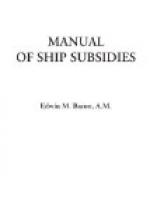That year (1907) the Government brought forward several ship-subsidy bills making provision for further Japan sea services.[FG] In 1908 the amount of State aid to the merchant marine had increased to an equivalent of $6,170,566 and additional amounts were asked for, one for the line to South America.[FH] The budget for 1908-09 carried the largest amounts yet devoted by Japan to ship subsidizing. At the end of 1908 official statistics placed the number of steamers at 1618, with a gross tonnage of 1,153,340.42. Of these, one hundred and one were steamers of more than three thousand tons.[FH]
In 1909 a new subsidy system was adopted (the laws of 1896 revised), to go into effect January 1 1910. The fixed navigation bounties granted by the old system on specified routes were abolished, and a general subsidy offered open to all steamships conforming to the provisions of the new law. The subsidized open-sea routes, however, were limited to four—the European, the North American, South American, and Australian;[FI] and coasting services in the Far East were not affected. Among other conditions imposed on the beneficiaries were the requirements that steamers must carry more than one-half their maximum load; that each must have a wireless telegraph outfit, this, however, instituted at the Government’s expense; that the Department of Communications be furnished with information as to freights and passenger rates; and that proper terminal facilities, as piers, warehouses, lighters, be provided by the subsidized companies.[FJ] The steamers receiving the full subsidy must be home-built, of steel, of over 3000 tons gross, and showing a speed of at least twelve knots per hour. The rate was fixed at fifty sen per gross ton for every thousand nautical miles, and ten per cent of this sum added per additional speed of one nautical mile an hour, according to the conditions of the route. Upon a vessel the age of which exceeds five years the subsidy decreases five per cent each year till the age of fifteen is reached, when it ceases. Foreign-built steamers under five years of age, which may be put in service with the sanction of the Government authorities, are entitled to half of the subsidy. The construction subsidies were arranged in two classes, and each class in four grades.[FK] The rates were slightly increased over those of the law of 1896, and their benefits were limited to steel vessels of over 1000 tons instead of 700 tons.
The total appropriations for ship subsidies in the budget for 1911-12 amounted, in American money, to $6,845,995, of which $6,294,020 were for navigation, and $551,975 for construction subsidies: an increase of $478,387 in the former class over the appropriation of the previous year, and a decrease in the latter class of $6,835.[FL]
The total Japanese tonnage in 1910 stood at 1,149,200 tons.[FM] The Nippon Yusen Kaisha practically owns nine-tenths of the ocean-going steamships flying the Japanese flag.[FN]




